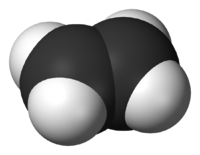
Photo from wikipedia
Intermolecular photoredox ene-carbonyl reductive coupling reactions typically have low product selectivity owing to competing dimerization and/or reduction of ketyl radicals. Herein, we report a metal-organic layer (MOL), Hf-Ir-OTf, as a… Click to show full abstract
Intermolecular photoredox ene-carbonyl reductive coupling reactions typically have low product selectivity owing to competing dimerization and/or reduction of ketyl radicals. Herein, we report a metal-organic layer (MOL), Hf-Ir-OTf, as a bifunctional photocatalyst for selective photoredox reductive coupling of ketones or aldehydes with electron-deficient alkenes. Composed of iridium-based photosensitizers (Ir-PSs) and triflated Hf12 clusters, Hf-Ir-OTf uses Lewis acidic Hf sites to bind and activate electron-deficient alkenes to accept ketyl radicals generated by adjacent Ir-PSs, thereby suppressing undesired dimerization and reduction of ketyl radicals to enhance the selectivity for the cross-coupling products. The MOL-catalyzed reductive coupling reaction accommodates a variety of olefinic substrates and tolerates reducible groups, nicely complementing current methods for cross-coupling reactions.
Journal Title: Journal of the American Chemical Society
Year Published: 2021
Link to full text (if available)
Share on Social Media: Sign Up to like & get
recommendations!